In the intricate world of horticulture, perhaps no practice commands as much mystique and admiration as bonsai cultivation, attracting every enthusiast. Immediately, one question springs to mind: “How Hard And Long Is It to Grow Bonsai Trees?”
By the end of this post, we hope to provide enough insights and guidance for you to make an informed decision about whether to adopt this fulfilling long-term hobby.
Growing Bonsai Trees: A Harmony of Nature and Art
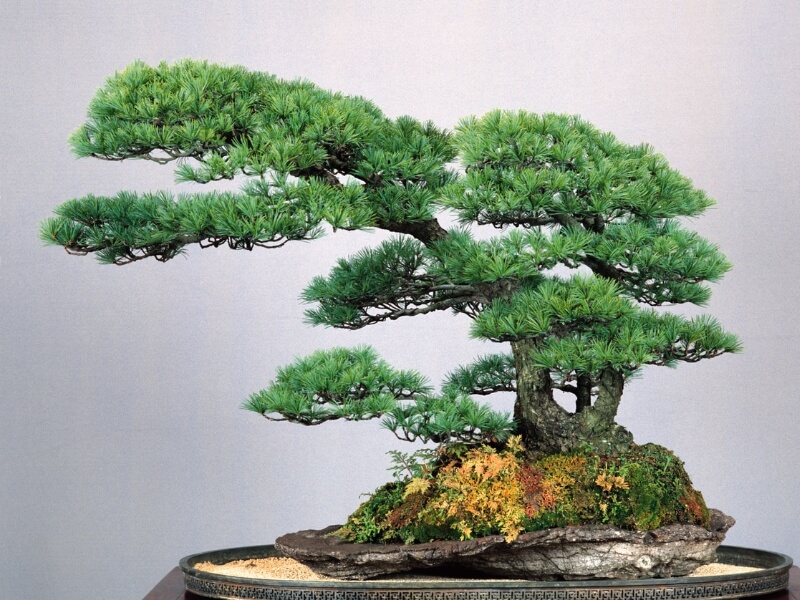
Origins
Bonsai blends horticulture and aesthetics in a unique synergy. The term came from the Japanese words ‘bon’ (tray) and ‘sai’ (planting), which literally translates to ‘plant in a tray.’ It is an art form that aims to create a miniaturized yet realistic representation of nature.
The practice originated in China over a thousand years ago, later refined by the Japanese into the bonsai art we know today. This art form has always been about more than just the trees themselves; it’s a holistic practice that encapsulates the beauty and essence of nature.
Goals
The primary goal of bonsai art is to create a balanced and harmonious relationship between the tree and its container, which leads many to wonder how hard are bonsai trees to grow. Despite their miniaturized size, most bonsai trees, like ficus bonsai and deciduous bonsai, should embody the elegance and grandeur of a fully grown tree in nature. It is this intrinsic balance of elements that gives the bonsai plant its soothing and serene quality. Part of this practice involves caring for your tree regularly.
Debunking Bonsai Tree Myths
Myth #1: Bonsai is a tiny plant.
Bonsai may be small in size, but it is not a tiny plant. Bonsai cultivation is an art form that aims to create a tree that looks as if it belongs in nature itself.
It requires patience, knowledge, and skill to create a bonsai. It takes years to do this, and although it may be small, it represents a fully grown tree that has been scaled down to a manageable size.
Myth #2: Bonsai is its own species.
One of the most common myths about bonsai is the belief that they are a specific species. In reality, a bonsai can be grown from almost any species.
From the hardy juniper bonsai and easy-to-care ficus bonsai to the delicate and elegant Japanese maples and camellias, the types of species that can be cultivated are countless.
Myth #3: Bonsai is a genetically modified plant.
Bonsai trees are not genetically modified. However, such trees are a result of hand-cultivation and grooming, which takes place over years or even decades. Bonsai tree cultivation is a technique that replicates normal trees in nature.
But rather than letting the tree grow and develop naturally, the growth is manipulated by techniques like pruning, trimming, and shaping.
Myth #4: Bonsai can only be grown indoors.
Bonsai can grow and thrive both indoors and outdoors if the right conditions are met. But that doesn’t mean that they’re strictly indoor plants.
The primary consideration when it comes to growing a bonsai tree outdoors is choosing the right species that can thrive in the climate. Some species can tolerate extreme winters, while others can’t.
Myth #5: Bonsai’s growth eventually stops.
It is a common misconception that bonsai trees do not grow, which is not true. With proper care, your potted masterpiece can continue to grow for decades and even centuries. This art lies in controlling the growth and shaping your potted masterpieces in specific forms to achieve the desired aesthetic effects. Just make sure they receive natural light (if indoors, consider placing beside a sunny window) and fresh air. Also, you must avoid over watering.
Myth #6: Bonsai cultivation is limited to only a few types of trees.
One of the many misconceptions surrounding bonsai, which raises the question of how hard are bonsai trees to grow, is that only a few types of trees can be cultivated into bonsai. This is not true, as almost any tree can be pruned, trained, and shaped to fit the art form of bonsai. Having said that, some species are more suitable for bonsai due to their smaller size, unique characteristics, and ease of maintenance.
Myth #7: Bonsai causes significant distress to plants.
Another common misconception is that the tree is subjected to a torturous process to achieve the desired size and shape, which is wrong. Bonsai trees need proper care to thrive, just like any other plant. With adequate sunlight, water, and nutrients, bonsai trees can grow to their full potential and for many decades.
Myth #8: Bonsai need extreme care.
Contrary to the myth that bonsais need to be babied, these miniature plants are incredibly resilient. They don’t require special water or constant incubation indoors. In fact, they thrive in natural environments, growing tougher and more beautiful over time. While they do need extra care after repotting, akin to post-surgery recovery in humans, it’s not a continuous necessity.
Myth #9: Bonsai care requires a “green thumb.”
The belief that you need a “green thumb” to grow bonsai trees is a misconception. The health of a bonsai often comes down to understanding its basic care requirements, not inherent talent. Just as rice farmers successfully cultivate vast fields without worrying about having a green thumb, anyone can maintain a bonsai with proper knowledge and care. In essence, we all have the potential for a green thumb. It’s all about not neglecting the tree’s horticultural needs.
Myth #9: Bonsai is a hobby of the rich.
Bonsai trees range in price, and some trees can be costly, but it is not a necessary expense for a beginner. One can go for inexpensive yet healthy tiny plants in a garden store, which can be pruned and trained into beautiful trees, making the art form accessible to anyone who wants to partake in it.
Myth #10: Bonsai is a solitary hobby.
Bonsai cultivation can be enjoyed alone, but it is not a solitary hobby. There are clubs and societies all across the world where enthusiasts share their love for bonsai. Members of such clubs meet regularly to exchange ideas and knowledge to learn and help each other. Joining a club can also offer you a chance to participate in exhibitions, workshops, and events.
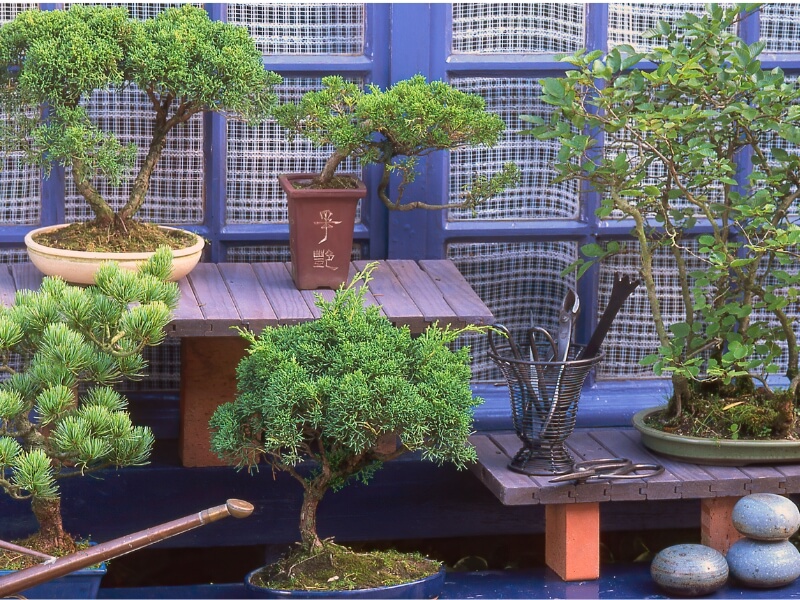
How Difficult Is Bonsai Cultivation?
When discussing how hard bonsai trees are to grow, it’s important to remember that bonsai cultivation is a practice of discipline and patience, requiring a mindful approach to the care and nurturing of the trees. It is not about instant gratification but rather the satisfaction derived from witnessing the gradual growth and development of your tree over time.
Learning to Work with Different Tree Species
Bonsai trees can originate from anywhere in the world and come in various shapes, sizes, and colors. As a tree grower, you need to learn how to work with different species, both outdoor and indoor bonsai trees, and determine which ones are suitable for bonsai.
Each species has unique needs for water, soil, sunlight, temperature, and other environmental factors. You need to understand how to balance those factors to keep your masterpiece healthy and thriving.
Understanding the Unique Needs of Each Species
Bonsai trees are not like normal plants; they are living artworks that require special attention, leading many to ask how hard are bonsai trees to grow. Understanding the unique needs of each tree is critical to cultivation success. You must learn how to prune, wire, and shape your trees appropriately and at the right time. You also need to know how to adjust the watering and fertilizing of your bonsai regularly to meet its changing needs.
For instance, tropical species may quickly dehydrate due to the rough texture of the soil and their placement in a shallow pot. Therefore, daily watering might be a necessity.
Developing Basic Horticulture Skills
Horticulture is the science of plant cultivation and management that includes soil management, pest control, and disease prevention, among other skills. Understanding the growing season of your bonsai plant and having the proper bonsai soil mix is crucial.
You must know how to recognize and treat common issues like root rot, insect infestation, and diseases that can harm your bonsai, especially during its growing season. You must also learn how to repot it and maintain the soil structure needed to promote root growth.
Basic knowledge of fertilizers and watering frequency is also essential. Pro Tip: Opt for granular fertilizers for larger trees; for smaller ones, a liquid feed is best as it won’t wash away and works well if you’re saturating the roots with water, as advised.
Cultivating the Virtue of Patience in Bonsai Growing
The art of bonsai growing is a practice that calls for an ample measure of patience. Unlike other plants that might respond quickly to care and attention, bonsais operate on a different timescale. It is crucial to remember that trees have their own unique rhythm and pace of growth, which is often slower than we might anticipate or desire.
When you make changes to your bonsai’s care—whether it’s altering its location, modifying watering schedules, adjusting feeding routines, or implementing new pruning techniques—it’s important to give the tree ample time to respond. This could take at least a month if not more.
Bonsai growing is not about instant gratification; rather, it’s about observing gradual transformations and developments. It’s about nurturing a living thing through careful attention and dedicated care and then patiently waiting for it to flourish in its own time.
Avoid the temptation to constantly change things around. If you keep altering the conditions without giving the tree sufficient time to adjust and respond, you’ll never be able to discern what works best for your bonsai.
Growing a bonsai is about learning to respect the natural pace of life and finding joy in the slow but rewarding process of nurturing growth. So embrace the virtue of patience, and let it guide you in your bonsai-growing adventure.
Ideal Cultivation Conditions for Bonsai
The optimal cultivation conditions for a bonsai depend on which bonsai tree species it belongs to. For instance, Ficus varieties require regular misting to maintain appropriate humidity levels around them, and they thrive in full sunlight. The watering preference for these types is lukewarm water rather than cold. As for the surrounding temperature, these trees don’t do well if it drops below 60 degrees Fahrenheit.
Jade bonsais bear similarities to succulents with their preference for abundant sunlight and minimal water. Since they store water in their leaves and stem, it’s more beneficial to underwater than to overwater them. They thrive best in a loamy soil mixture with excellent drainage capabilities.
How Long Does It Take for Bonsai Trees to Grow?
Understanding the time it takes to grow a bonsai tree is crucial for any enthusiast beginning their journey. The growth rate and development of a bonsai tree depend on several factors, including the species of the tree, the conditions under which it is grown, and the care it receives.
1. Species Variability
The time it takes for a bonsai to reach maturity can vary significantly depending on the species. For example, fast-growing species like the Chinese Elm or Japanese Maple can start to take shape within three to five years, showing substantial growth and allowing for initial styling and training. In contrast, slower-growing species such as the Juniper or Pine might take several years longer to develop the same level of maturity and style readiness.
2. Initial Growth Phase
From seed or cutting, the first few years are crucial and generally dedicated to growing the trunk. During this phase, the tree is usually left to grow with minimal pruning to allow it to thicken and gain strength. This can take anywhere from 3 to 10 years depending on the tree species and growing conditions. Trees grown from seeds require a longer period to establish a substantial trunk compared to those started from cuttings or nursery stock.
3. Training and Styling Phase
Once the trunk has developed sufficiently, the next phase involves detailed training and styling, which is the essence of bonsai art. This includes pruning branches and roots, wiring to shape branches, and repotting in appropriate bonsai soil. This phase is ongoing and can continue for the tree’s entire life, but the initial styling to get the tree into a basic bonsai form might take an additional few years of careful attention and adjustment.
4. Maturation
Even after a bonsai has been styled, it continues to grow and evolve. A bonsai is never truly finished; it requires continuous care and periodic restyling to maintain and refine its shape. Over decades, a bonsai can develop a thick, gnarled trunk and a mature, well-balanced canopy, characteristics highly prized in bonsai cultivation.
5. Environmental Factors
The environment in which a bonsai is grown—such as light, temperature, and humidity—also plays a significant role in its growth rate. Bonsai trees grown outdoors where seasons change naturally tend to have a more predictable growth pattern, while those grown indoors may grow more slowly due to less ideal conditions.
Bonsai Tree Growth Stages
Unfolding across multiple stages, the life of a bonsai mirrors a captivating tale of growth, transformation, and refinement. Each stage, integral in its own right, contributes unique elements to the tree’s journey, shaping its ultimate manifestation.
Stage 1 – Bonsai Seeds and Saplings

The birthplace of every bonsai is within its seed. Just like any other tree, a bonsai begins as a tiny seed that, given the right conditions, will sprout into a sapling. This initial stage is crucial because it lays the foundation for the tree’s future development.
While some enthusiasts prefer to purchase young trees, starting with bonsai tree seeds allows you to shape and influence the tree from its earliest days. You can collect tree seeds yourself and use a variety of methods to sprout them.
The seeds should be sown in a shallow tray with well-draining soil. After this, they require careful watering and adequate sunlight to germinate successfully.
Stage 2 – Early Bonsai Development

Once your existing bonsai tree sapling has established itself, the early development stage begins.
This phase, crucial for a bonsai tree to grow, can last several years and involves nurturing the tree as it grows and begins to take shape. During this time, you will begin to shape the tree using wires to guide its growth. It’s during this stage that the general shape and style of the bonsai start to emerge.
This stage requires careful attention and frequent care, including regular watering, periodic feeding, and protection from harsh weather conditions. Patience is key here; remember, keeping a bonsai healthy is not a race but a journey.
Stage 3 – Development of Secondary Structure
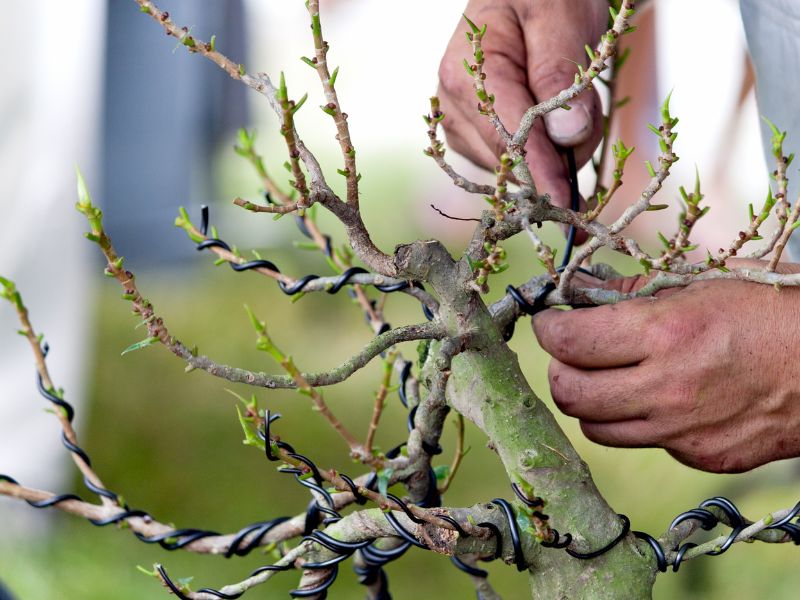
As the tree matures, you’ll move into the secondary structure development stage. This is when the tree’s branches and leaves start to fill out, giving your bonsai a more robust and tree-like appearance.
During this stage, you’ll continue to use wiring techniques to shape the branches and trunk further. However, you’ll also begin to prune the tree more heavily to maintain its size and encourage denser foliage.
This is also the time when you might consider repotting your bonsai into a more aesthetically pleasing pot that complements its style and size.
Stage 4 – The Refinement Stage
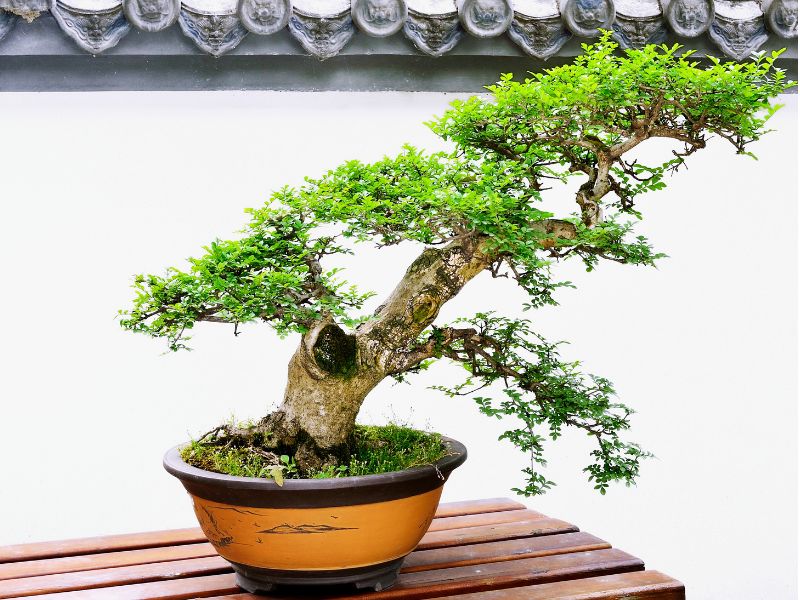
Finally, after years of careful cultivation, your typical bonsai will enter the refinement stage. This is when the tree reaches its peak aesthetic value and healthy life, looking like a miniature version of a full-sized tree.
At this point, your focus will shift from shaping the tree to maintaining its health and appearance. Pruning your tree regularly will keep the tree’s size in check, while careful watering and feeding will ensure it remains healthy.
During this stage, your bonsai may also begin to flower or bear fruit, adding another layer of beauty to your miniature masterpiece. It’s a beautiful testament to the time, care, and patience you’ve invested over the years.
Factors Affecting The Ability Of A Bonsai Tree To Grow

Species
The species of the tree plays a significant role in bonsai cultivation. Different types of trees have varying requirements for sunlight, water, and temperature.
For instance, Juniper bonsai trees thrive best in cooler climates, while slow growers, such as Ficus bonsai prefer warmer temperatures. Understanding the specific needs of your chosen species is crucial for its successful growth and development.
Climate
Climate is another vital factor for the bonsai tree to grow successfully.
Most bonsai trees can handle extreme temperatures, while others may need a more mild climate. Indoor bonsai trees usually require a stable environment, while outdoor bonsai trees are often more resilient and can adapt to changing weather conditions.
It’s essential to do proper research on the ideal climate for your particular bonsai tree species to ensure it thrives.
Soil
The right soil mix can significantly influence the health and growth of your bonsai tree. Ideally, the soil should be well-draining to prevent waterlogging, yet it should also retain enough moisture to keep the roots hydrated. It’s also important to consider the pH level of the soil, as different trees have different preferences for acidic or alkaline conditions.
Watering
Watering is a delicate balance when it comes to bonsai care. Too much water can lead to root rot, while too little can cause the tree to dry out and die. The frequency and amount of watering will depend on various factors, such as the size of the tree, the size of the pot, the type of soil, the climate, and the growing season of the tree.
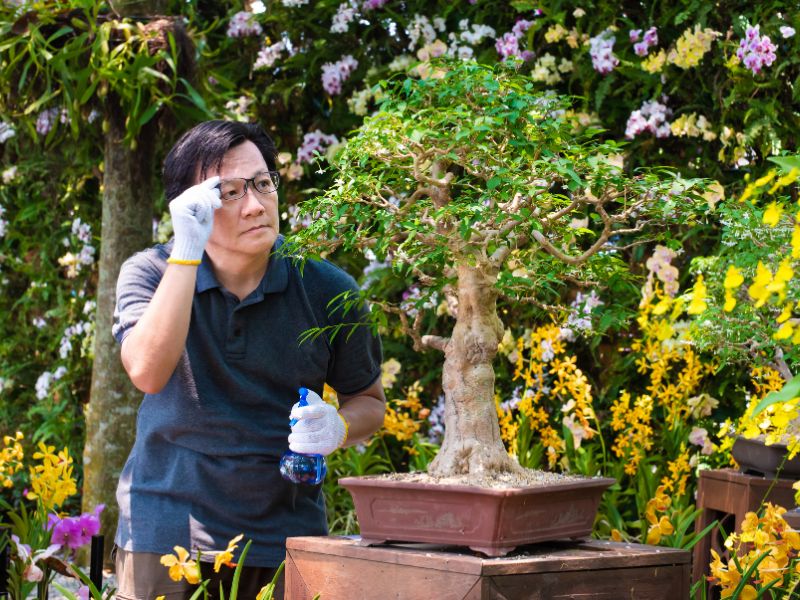
Nutrition
Just like any other living organism, bonsai trees need nutrition to grow. This is usually provided in the form of fertilizer. The right fertilizer will provide the necessary nutrients your bonsai needs, including nitrogen for leaf growth, phosphorus for root development, and potassium for overall health and resistance against diseases and pests.
Pruning
Pruning is an integral part of bonsai artistry. It helps maintain the miniature size of the tree, encourages the growth of new branches, and shapes the tree to the desired design. Regular root pruning is also necessary to keep the roots from outgrowing the pot. Pruning techniques vary depending on the type of tree, desired shape, and size of the bonsai.
Potential Diseases and Pests
Despite our best efforts, bonsai trees can sometimes fall victim to diseases and pests. Common issues include fungal infections, aphids, and spider mites. Regular inspection of your bonsai can help catch these problems early. If detected, appropriate treatment should be applied promptly to prevent further damage.
What’s the Fastest Growing Bonsai Tree?
If you are keen to see quicker results, certain bonsai species are known for their rapid plant growth rates. These species offer both novice and seasoned enthusiasts the opportunity to witness the transformation of their miniature trees in a relatively shorter span.
Here are some of the fastest growing bonsai trees:
Arborvitae Green Giant
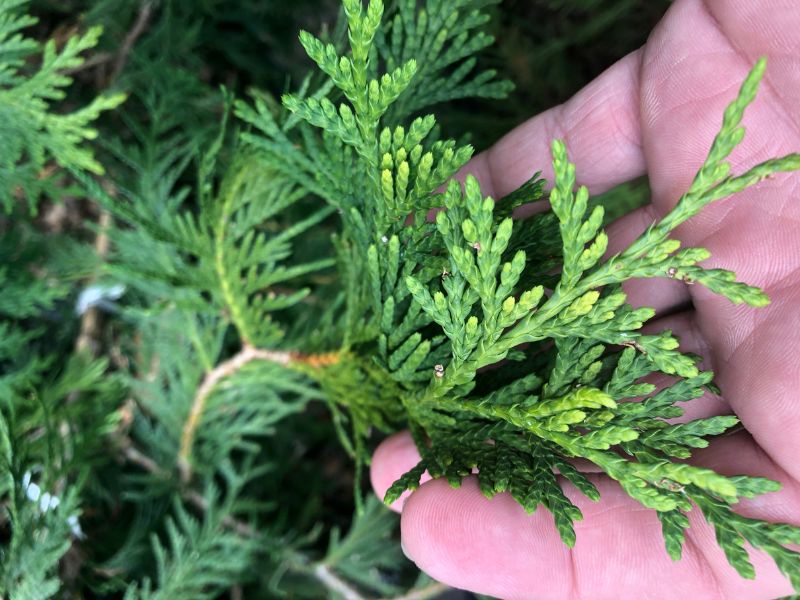
The Arborvitae Green Giant is an impressive bonsai tree that is known for its rapid growth rate. This bonsai species can thrive both indoors and outdoors, making it a versatile choice for any bonsai enthusiast. Its strong root system allows it to adapt well to the confines of a bonsai pot, promoting quicker growth compared to other species.
Portulacaria Afra
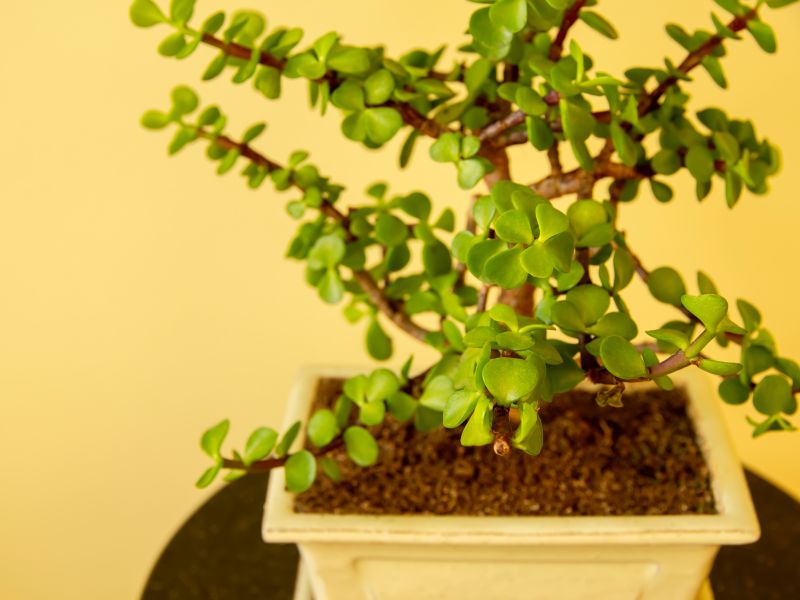
Portulacaria Afra, also known as Elephant Bush or Dwarf Jade, is another fast-growing bonsai tree. It’s an ideal choice for beginners due to its hardiness and ability to withstand a variety of conditions. Not only does it grow quickly, but it also offers a unique aesthetic with its succulent leaves and thick, woody trunk.
Weeping Willow
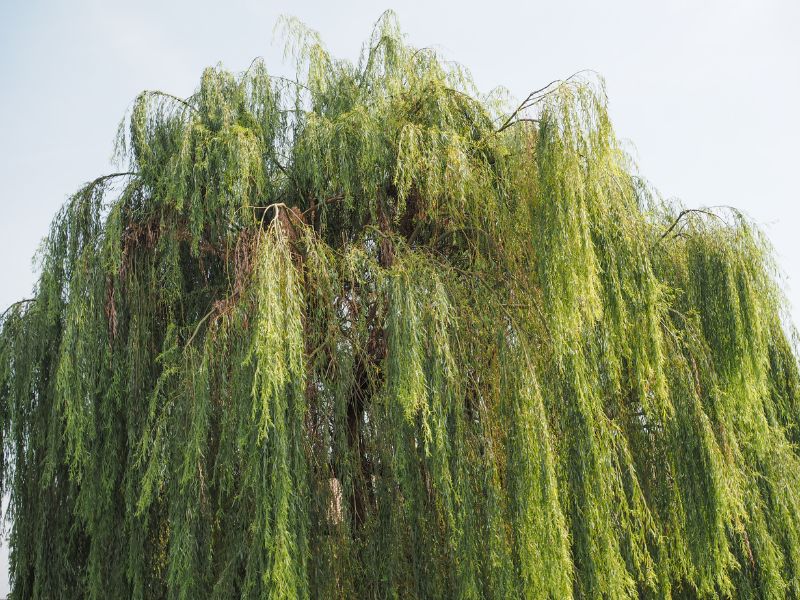
The Weeping Willow is a classic choice for a bonsai tree due to its distinctive drooping branches and elegant form. Known as one of the fastest-growing bonsai trees, it can provide an impressive display in a relatively short amount of time. The weeping willow bonsai is especially popular for its dramatic appearance, resembling a full-sized weeping willow in miniature.
Japanese Maple
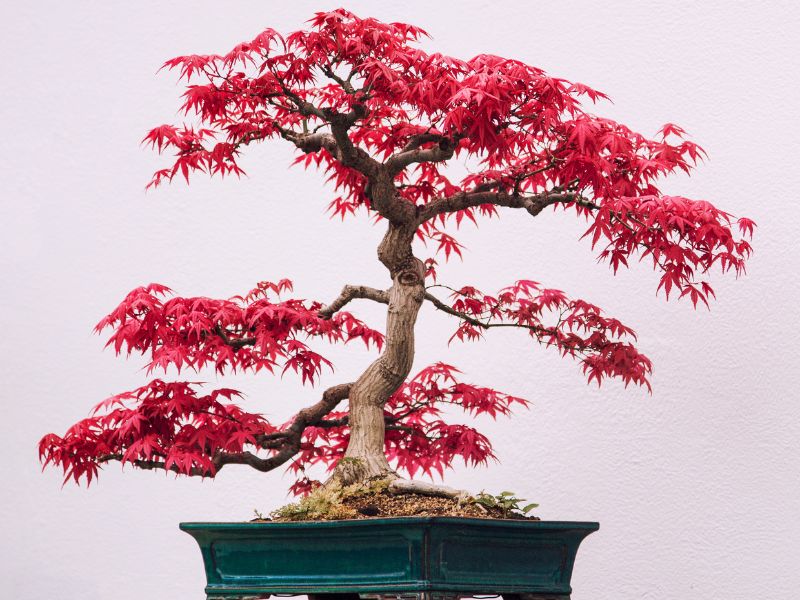
The Japanese Maple is another species that grows at a relatively quick pace. Japanese Maples are cherished for their beautiful leaf coloration and the delicate, lacy appearance of their foliage. These fast growing trees are ideal for those looking for a visually striking bonsai that grows quickly.
Redwood and Juniper
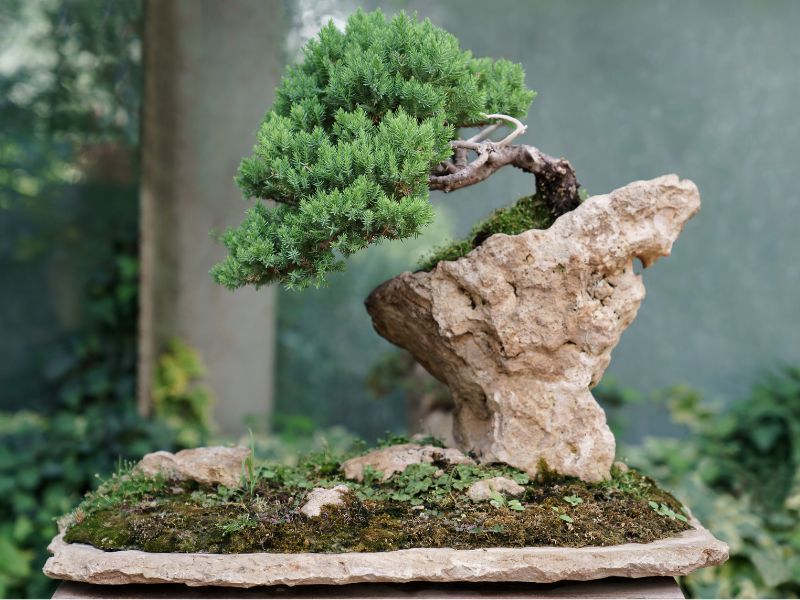
Redwood and Juniper are two more species that are known for their fast growth rates. Both of these trees offer unique aesthetics to your bonsai collection. Redwoods are loved for their height and slender trunks, while junipers are appreciated for their dense foliage and resistance to harsh conditions.
Monitoring Your Bonsai’s Progress
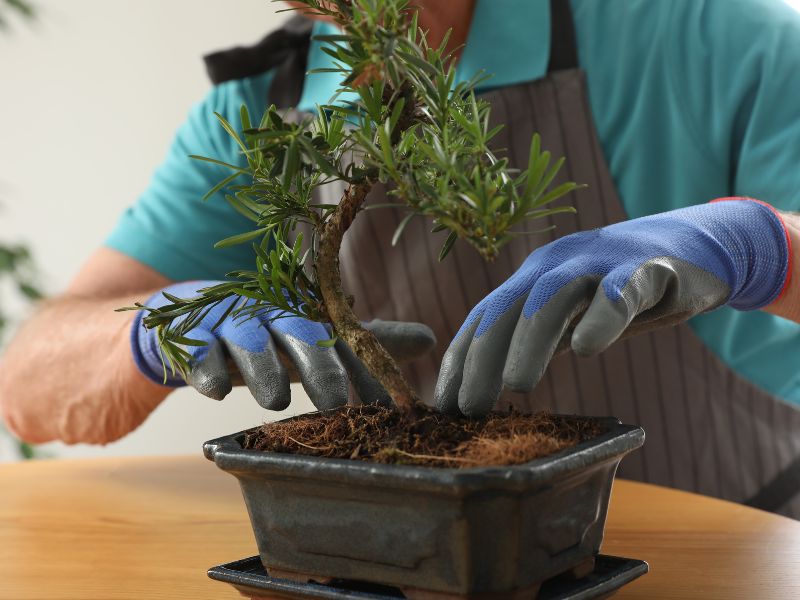
Observing and Documenting Changes
The first step in monitoring your bonsai tree to grow is to observe and document changes. Each bonsai tree is unique, growing and reacting to its environment in its own way. Observing these changes will allow you to understand the rhythms and patterns of your bonsai and respond accordingly.
Develop a habit of closely examining your bonsai each day. Look at the leaves, branches, trunk, and roots. Take note of any changes in color, shape, or size. Any significant changes could be a sign that something is amiss.
To aid in your observations, consider keeping a bonsai diary. Document the changes you see and the care you provide each day. This can help you identify trends over time and make adjustments as needed. Photos can be particularly helpful in tracking progress. A quick snapshot every week can provide a visual timeline of your bonsai’s development.
Understanding Your Bonsai’s Needs
Understanding the needs of your bonsai is crucial in monitoring its progress. Each species of bonsai has specific requirements in terms of light, water, temperature, and nutrients. Researching and understanding these needs will enable you to provide the best possible care for your bonsai.
Watering, for instance, is a critical aspect of bonsai care. However, each bonsai has different water requirements. Some bonsai trees prefer their soil to be slightly dry between watering, while others prefer consistently moist soil. Learn what your particular bonsai prefers and adjust your watering schedule accordingly.
Taking Appropriate Actions
Once you’ve observed changes and understood your bonsai’s needs, the next step is to take appropriate action. This might involve adjusting your watering schedule, moving your bonsai to a location with different light conditions, or changing the type of fertilizer you use.
Pruning is another important part of bonsai care. Regular pruning helps maintain the miniature size of the tree and shapes it into a desired form. However, this isn’t just about aesthetics. Pruning also promotes the health of the tree by removing dead or diseased branches.
Tips for Faster Bonsai Growth

#1 | Choose the Right Species
The first step towards faster bonsai growth lies in the choice of your tree species. Some varieties naturally grow faster than others. For instance, the Ficus family, Junipers, and Pines are known for their relatively fast growth rates. Additionally, these species are also hardy, making them ideal for beginners.
#2 | Optimal Placement
Bonsai trees thrive in environments that closely mimic their natural habitats. Therefore, understanding the specific needs of your chosen species is crucial. Most bonsai prefer full sunlight, while others need a mix of sun and shade. For indoor bonsai, place them near a south-facing window to ensure they receive ample light.
#3 | Regular Watering
Watering is a vital aspect of bonsai care. Too much water can lead to root rot, while too little can cause dehydration. A general rule to follow is to water your bonsai when the topsoil feels dry to the touch. Moreover, it’s best to water in the early morning or late evening to prevent rapid evaporation.
#4 | Proper Fertilization
Fertilizers play a significant role in promoting faster growth. They provide essential nutrients that the tree might not get from the soil alone. Use a balanced fertilizer, ideally one formulated for bonsai trees, and follow the manufacturer’s instructions regarding frequency and quantity.
#5 | Regular Pruning
Pruning is an essential part of bonsai artistry. It not only shapes the tree but also encourages new growth. Regularly prune your bonsai to maintain its shape and promote denser foliage. Remember, pruning should be done carefully to avoid damaging the tree.
#6 | Repotting
Over time, your bonsai tree will outgrow its pot. When this happens, the roots can become constricted, slowing the tree’s growth. Repotting every two to five years, depending on the tree’s size and species, can help ensure your tree has enough room to grow.
#7 | Disease and Pest Control
Keeping your bonsai tree healthy is essential for its growth. Regularly inspect your tree for signs of disease or pests. If detected early, most issues can be easily treated with organic or chemical solutions.
Assessing Your Commitment

Before embarking on your bonsai journey, take a moment to reflect and assess your commitment to this art form. Growing bonsai indoors or outdoors is a delightful hobby that requires time, patience, and dedication. Here are some questions to consider:
- Are you able to dedicate sufficient time to its care and maintenance?
- Do you have the patience to watch it grow and develop over months and years?
- Are you prepared to learn about different species and their specific needs?
- Are you ready to invest in the tools and resources required for cultivation?
- Are you committed to ongoing learning, including understanding more about horticulture techniques and practices?
- Are you resilient enough to deal with occasional setbacks, such as a tree not growing as expected or being affected by pests or diseases?
If you can answer ‘yes’ to most of these questions, you are likely ready to commit to this art.
Remember, it’s not just about having a beautiful plant; it’s about the journey of creating and maintaining your very own living piece of art.
Some Challenges and Rewards of Bonsai
Embarking on the journey of bonsai cultivation may present some challenges for beginners, leading one to question how hard are bonsai trees to grow. Yet, this path carries with it an unparalleled sense of fulfillment. Here are some potential obstacles and rewards to consider:
Challenge: Time and Patience Requirement– Bonsai cultivation is a delicate and slow process requiring regular care and attention. You must have the patience to let the tree grow at its own pace.
Reward: Personal Growth and Discipline– The patience and commitment that keeping a tree alive demands can lead to personal development. It encourages mindfulness, attention to detail, and a sense of discipline.

Challenge: Learning Curve– Understanding the unique needs of different species and mastering regular pruning and wiring techniques can be daunting initially.
Reward: Mastery of a Unique Art Form – As you overcome these hurdles and acquire new skills, you will find yourself mastering an incredible art form.

Challenge: Setbacks– Despite your best efforts, your bonsai may sometimes face health issues or growth problems.
Reward: Enhancing Problem-Solving Skills – Such setbacks provide opportunities to enhance your problem-solving capabilities and resilience. But seeing your bonsai flourish and shape up exactly as envisioned provides immense satisfaction, making the entire journey worthwhile.
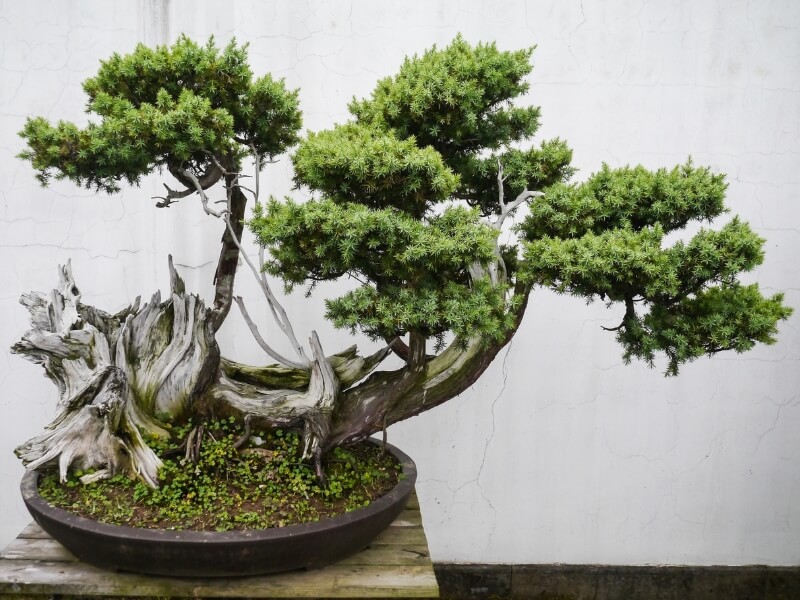
Tips for Getting Started in Bonsai
1. Choose the Right Bonsai for You
Choosing the right bonsai is the first step in your journey. Consider factors such as the bonsai species, size, age, and shape that appeal to you.
When considering the environment for growing trees, it’s important to think about the specific needs of indoor bonsai species that thrive indoors, as well as those that prefer the outdoors.
Whether you’re drawn to a larger bonsai that commands presence or a smaller bonsai that fits neatly on a desktop, choosing the right species is vital for your journey.
2. Invest in Quality Tools
A bonsai tree requires specific tools for maintenance, such as pruning shears, branch cutters, and root hooks. Investing in quality tools will ensure your tree receives the care it needs to thrive. Choose tools that are comfortable to handle and last a long time.
3. Prioritize Regular Care
Regular care is critical for the health and growth of your tree. This includes consistent watering, proper feeding, providing fresh air, and strategic pruning. Monitor your bonsai closely for any signs of disease or pests.
4. Learn from Others
Engage with the bonsai community to learn from other enthusiasts. Joining a club or society is a great way to share experiences, gain insights, and learn new techniques. Online forums and social media groups dedicated to bonsai are also useful resources.
5. Read Up on Bonsai
Knowledge is power when it comes to bonsai cultivation. Check out our blog posts “What Is the Definition and Meaning of Bonsai?” and “How to Care for a Bonsai Tree.” These blogs contain valuable insights for beginners and can provide answers to some common questions.
6. Practice Patience and Enjoy the Journey
Lastly, remember that bonsai is an art that requires time and patience. Each step in your journey, from choosing the tree to shaping and maintaining it, is a learning experience. Enjoy this process and take pride in the growth and development of your tree.
Your Bonsai Journey: A Path of Discovery, Growth, and Inspiration
Engaging in the art of bonsai is truly a journey of discovery, discipline, and personal growth. But how hard and long is it to grow and maintain bonsai trees? The hurdles you encounter along this path aren’t obstacles but stepping stones that guide you toward mastering this unique and ancient art form. It’s a rewarding and challenging endeavor that cultivates both patience and beauty.
The beauty of bonsai, such as the deciduous bonsai and Chinese elm bonsai, is found not just in the finished tree but also in the process of its creation and care. Deciding to adopt cultivation as a long-term hobby is indeed a mindful choice.

We hope that the insights and information provided here will guide you as you grow bonsai trees. Additional knowledge can be gained from other blog posts available on our website.
If you’ve already embarked on your bonsai journey and started caring for your own miniature masterpieces, we’d love to hear about your experiences. The successes, the challenges, the surprises – share them all in the comments section below. Your insights can help guide and inspire others who are just starting their own bonsai adventure.




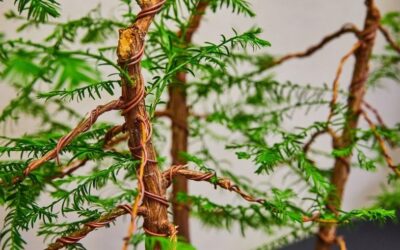
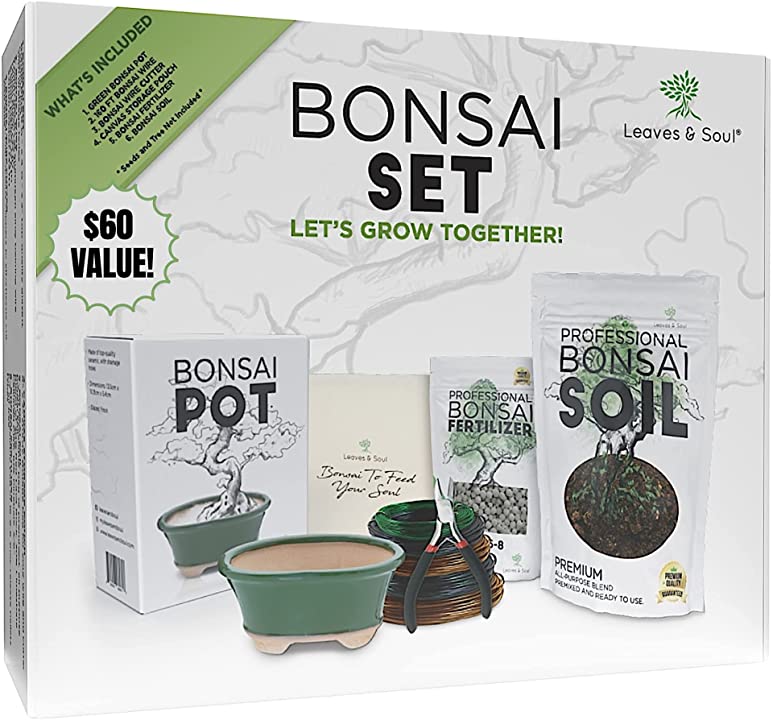
0 Comments